

Taking care of your van might be second nature before any trip, but maintaining your tow vehicle is just as important for a safe journey. Here's some expert advice to get you started.
There are many aspects to making and keeping a tow vehicle ‘tow worthy’. Tow vehicles are fitted with a number of accessories specifically related to towing, such as tow bars and electrical connections to name a couple. Setting the car up correctly for towing is something that can be overlooked, such as running different tyre pressures. A vehicle also works harder when lugging a caravan or camper trailer around, so a regular maintenance routine can become even more important. On top of this, understanding and correctly loading the tow vehicle is critical. Some of us have modern vehicles with fancy gadgets and low kilometres. Some of us have older tugs that need more attention and TLC. While we don’t have room to cover everything, this article tackles some of the basics of these issues.
Tow euipment
The connection between the tow vehicle and van is among the most fundamental of all considerations. It starts with the towbar bolted to the chassis. The bolts should be checked periodically that they are tight. On older vehicles, the towbar should also be checked for excessive corrosion. The towball tongue is retained in the towbar with a hitch pin, and this should be visually inspected for correct fitment, irregular wear or corrosion and that the retaining clip is in place. Similarly, the towball or pin should be checked for irregular wear and that it is correctly rated for the application.
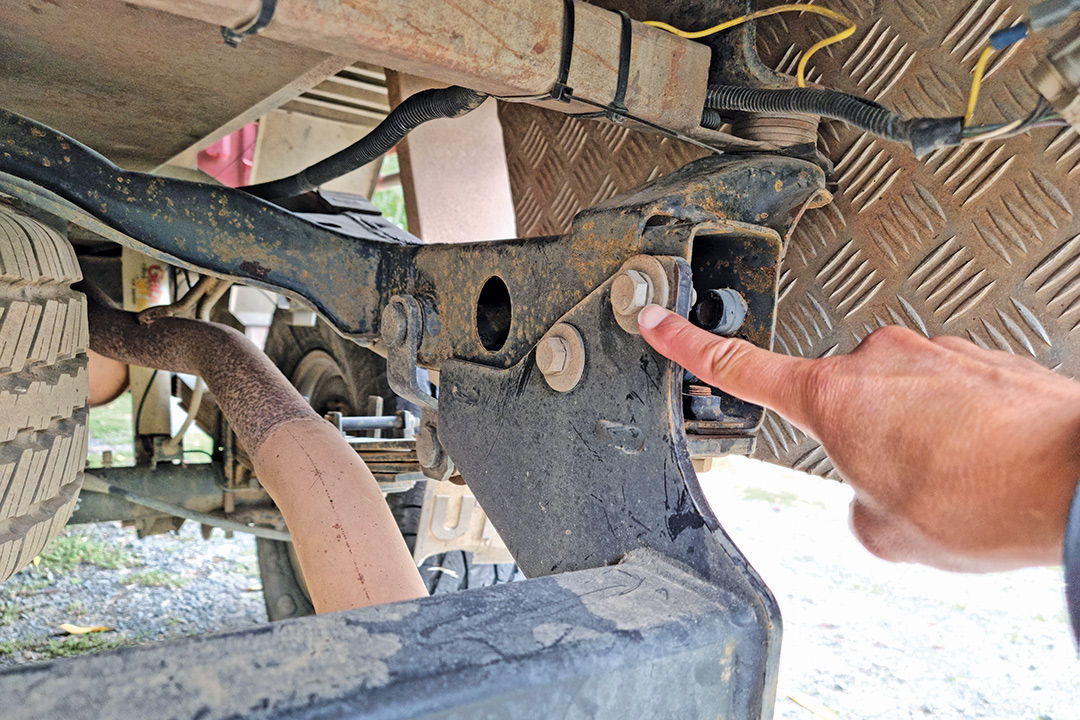 Check your towbar mounting bolts
Check your towbar mounting bolts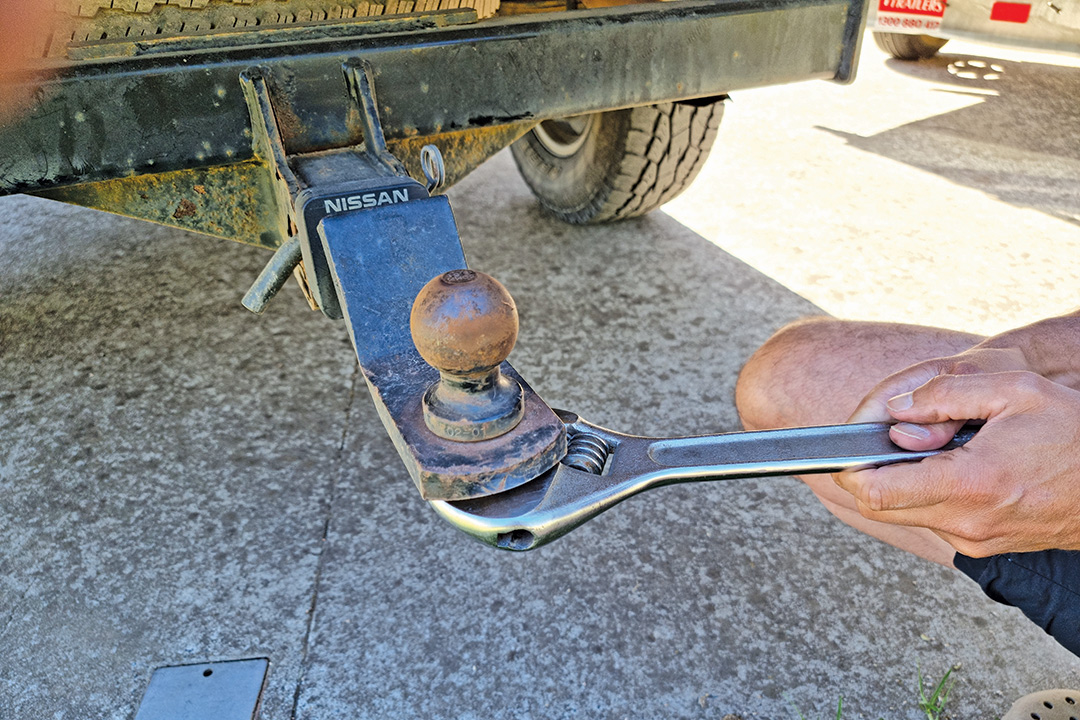 Ensure the towball nut is tight
Ensure the towball nut is tight
Some tow vehicles can benefit from a weight distribution hitch to improve the handling and safety of the rig. A caravan can impart a heavy load on the rear of the tow vehicle causing the rear of the car to sag and the front to rise. A ‘light front end’ causes the front tyres to have less contact patch on the ground which is detrimental to braking and cornering. A weight distribution hitch lifts some of the load off the car's rear axles and transfers it to the front axles, restoring balance. It is worth noting that some vehicle manufacturers specify weight distribution hitches as mandatory, while others prohibit their use.
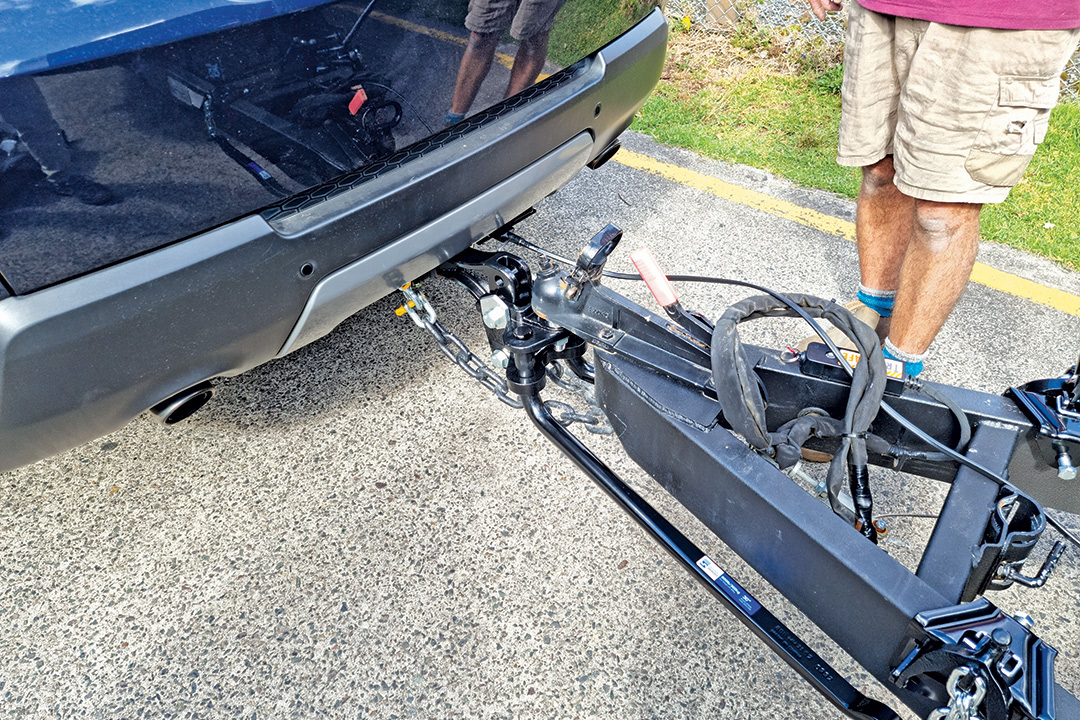 A weight distribution hitch can improve handling
A weight distribution hitch can improve handling
Caravans are generally wider than tow vehicles, which limits the driver's rear visibility with side mirrors. Wider mirrors are usually required by law to address rear visibility and to be able to see down the sides of the van. Broadly, tow mirrors come in two forms. The most basic types are secondary mirrors that temporarily attach to your vehicle that sit out wider than standard. The fancier types are aftermarket mirrors that replace the factory mirrors and can be moved to a wider position when towing and then moved back in when not towing. Another very useful form of rear vision enhancement is cameras. Fundamentally, a camera is attached to the rear of the van and the image is sent to a screen mounted inside the tow vehicle. While very useful, they do not supersede the need for mirrors.
Another critical piece of safety equipment is the tow vehicle’s brake controller. This is a device installed in the car which sends a signal to the caravan to activate its own brakes when you put your foot on the brake. This system is in place because in nearly all instances the tow vehicle manufacturer will require the van to have its own braking power so the car is not doing all the stopping work. The brake controller can be adjusted to vary the amount of braking force applied to the van when the car brake system is applied.
We can’t overlook the humble trailer plug that sends light signals to the van for tail lights, brake lights and indicators. The obvious thing to do is check all the lights are working when you hook up. A handy little trick is to turn the hazard lights on instead of the indicators so you can check left and right in one go.
Car setup
There are also variables that you can change in your tow vehicle to make it ideal for safe towing. Most car manufacturers will call for a higher tyre pressure when loaded, such as when the weight of the caravan is connected. This is to protect the tyres from deforming. Refer to your car manual for your specific requirements.
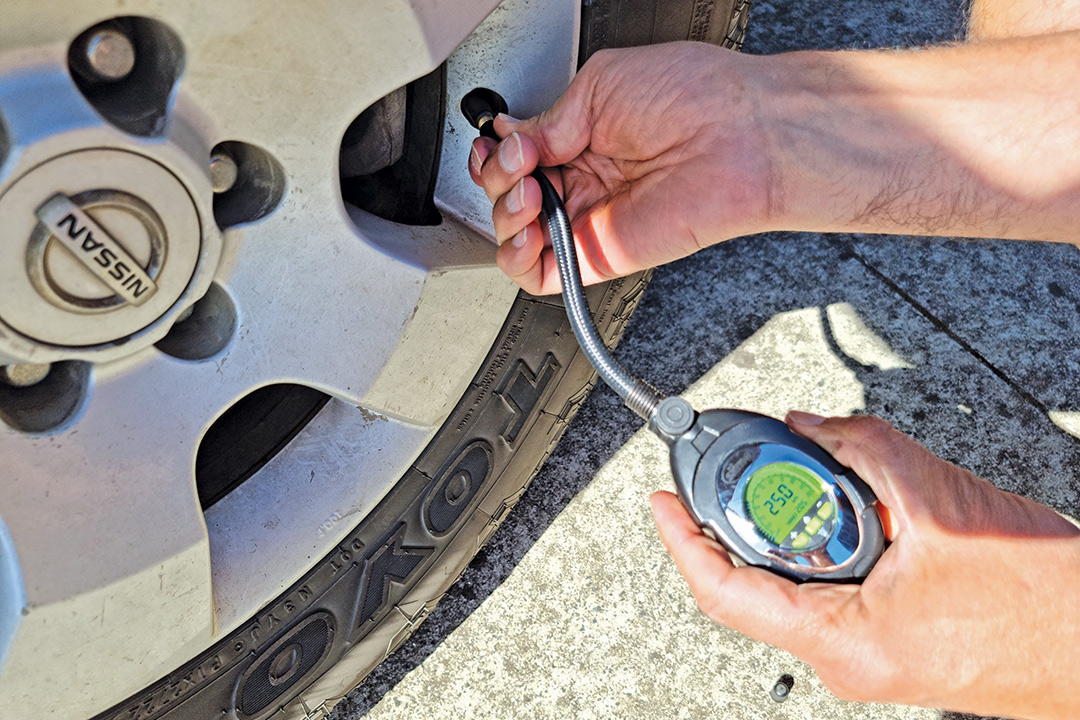 Check tyre pressure
Check tyre pressure
Many modern vehicles now feature advanced driver assistance systems known as ADAS. They are designed to detect hazardous situations and if necessary, take control of braking, acceleration and steering to prevent collisions. In some vehicles, some functions are not compatible or behave differently when a trailer is connected. These are generally related to monitoring and responding to what is happening behind the tow vehicle. Some ADAS features may interpret the caravan as another separate vehicle and initiate steps to prevent what it interprets as a potential collision scenario. Therefore, some vehicles have a requirement to turn off certain features when towing. Others require you to input the length of the trailer behind you, so ADAS knows when it is dealing with a separate vehicle or not. Other vehicles simply require a tow mode to be selected so it will sort out what features should be running and how when a trailer is connected.
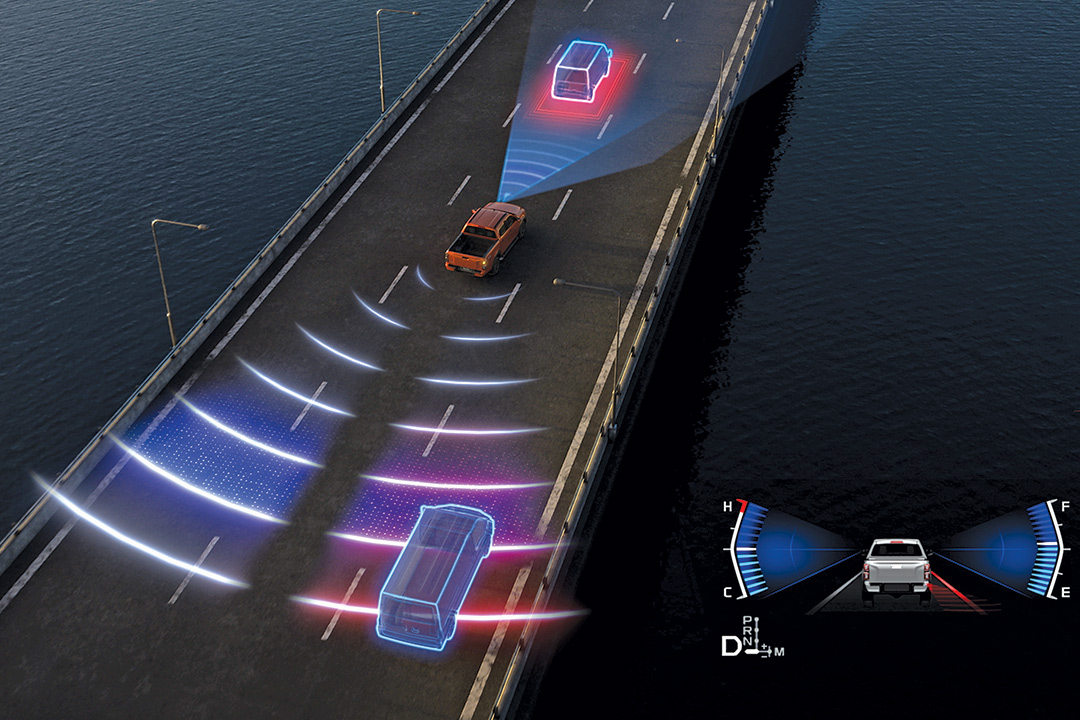 Some vehicles require certain safety features to be turned off when towing
Some vehicles require certain safety features to be turned off when towing
Maintenance
Vehicle maintenance is always important and particularly so for a tow vehicle due to the extra loads involved. In fact, car manufacturers often call for more frequent servicing if the vehicle is regularly used for towing, so it pays to check your manual carefully for special requirements. One of the main reasons for regular maintenance and checks is heat and time cause vehicle fluids to degrade. Leaks can also cause fluid levels to drop. So the basics should include checking the levels for your engine oil, coolant fluid, brake fluid, power steering fluid and automatic transmission fluid if accessible. It is critical if you do a top up that you add fluids that are compatible with what you already have in your system as the wrong fluid can cause major system failures.
Inspections should also include keeping an eye on the tyre treads for wear, particularly as it may be accelerated with towing. Tyres have little bumps protruding partway up the depth of their main grooves. When the tyre wears down to the level of these wear indicator bumps, the tyre needs to be replaced. Signs of uneven wear should also be monitored. Wear on one side of the tyre indicates there is some form of misalignment that needs to be corrected. Wear on the outside edge of tyres indicates under-inflation and wear through the centre of the tyre indicates over-inflation.
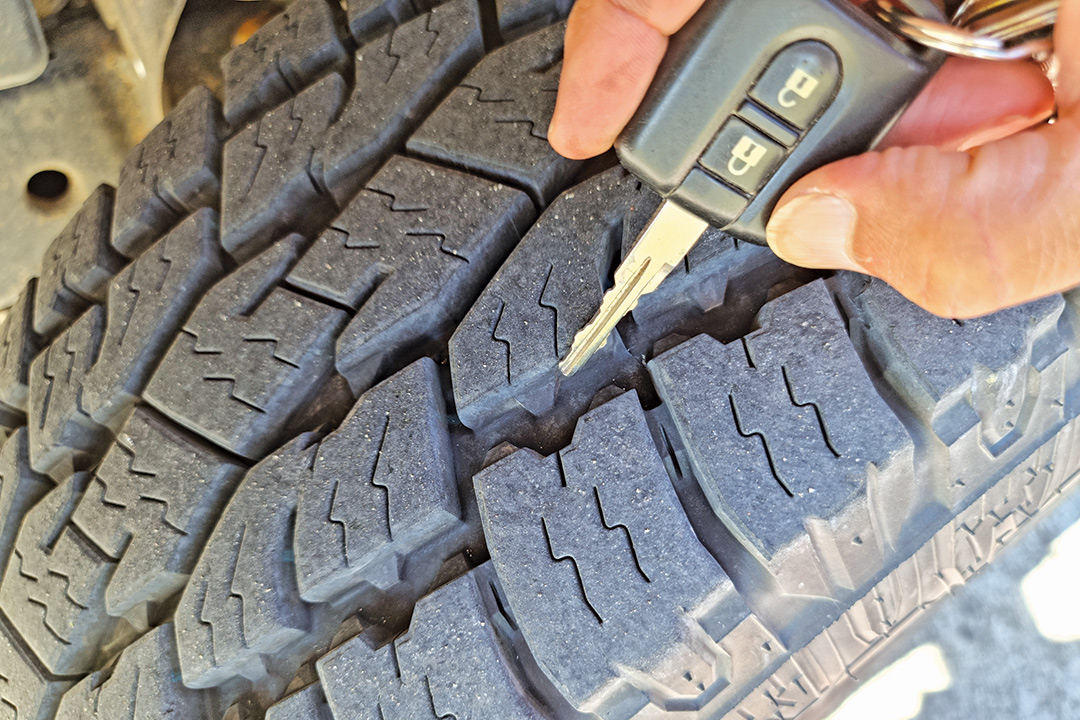 Check tyre wear
Check tyre wear
Vehicles that have operated in offroad or outback conditions can end up with dirt or other debris clogging the fins in radiators or transmission coolers, preventing airflow and thus overheating. A gentle application of compressed air can be used to clear the delicate fins without damaging them.
Another preventative measure worth doing is to check that your CV rubbers are not torn, cracked or otherwise damaged. A damaged rubber will allow grease to escape and moisture and dirt to get in causing premature failure.
Loading
There are several critical load requirements relating to your car when you are towing. We can’t stress enough never to attach a van to your car without understanding and complying with the below so you can remain safe and within the legal limit. The first and easiest to understand is your vehicle’s tow rating. Put simply, this is how much weight the car can pull and equally importantly, stop with. Next is the towball rating which is how much weight can be imparted on the rear of the car at the towball. It doesn’t seem to come up so often but you should be aware of the front and rear axle load ratings of your car. A heavy van is going to put a lot more load on your rear axle and take some load off your front axle. However, accessories such as bullbars and winches add considerably more load to your front axle.
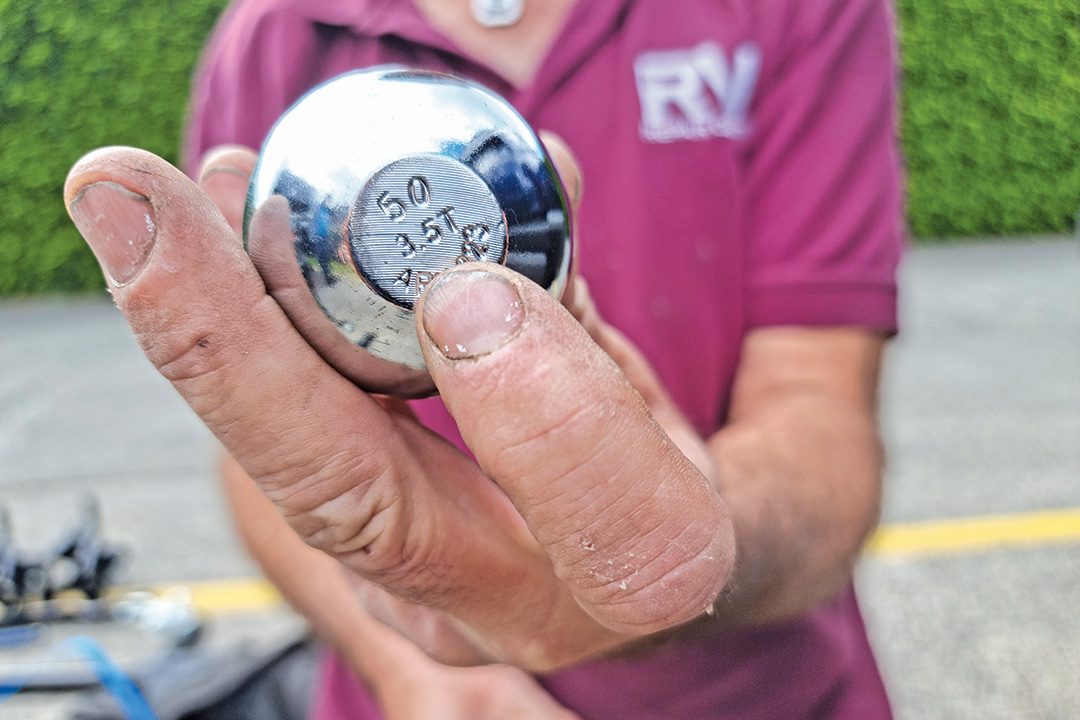 Use a correctly weighted towball
Use a correctly weighted towball
Getting a little more complex is the gross vehicle mass (GVM). This is the total weight the tow vehicle can be when loaded. This includes luggage, passengers, accessories fitted to the car and importantly, the portion of the weight of the van imparted onto the vehicle. And the most complex is gross combined mass (GCM). This is a spec determined by the car manufacturer stating what the total maximum weight of the car and van/trailer can be when they are loaded. You need to be careful because this number can be lower than the sum of the GVM and ATM (total weight allowed for the van). The reality is the only way you are going to know if you comply with these weight requirements is to weigh the tow vehicle and van.
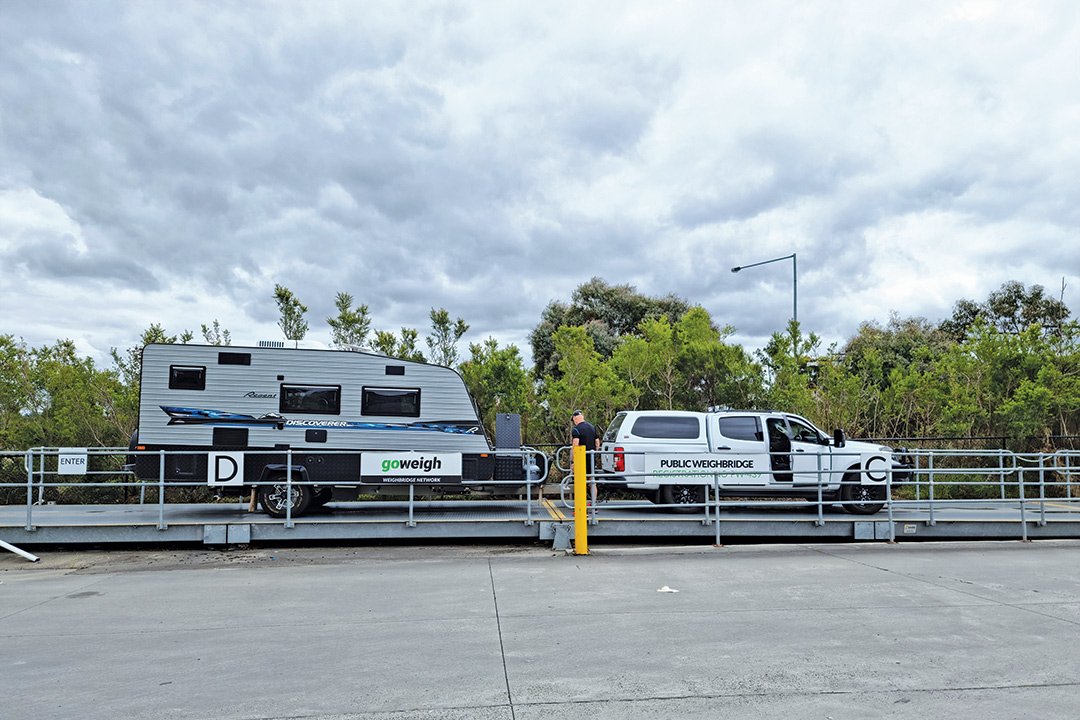 The only way to know your tow vehicle's load is to weigh it
The only way to know your tow vehicle's load is to weigh it
The wrap
There are a lot of areas to stay on top of to keep your tow vehicle running and handling well, plus stay safe and abide by any legal requirement. Many just involve the simple discipline to perform routine checks. Others involve always being conscious about how your rig is loaded. For most people, some jobs are best left to the professionals, but the more you understand, the more likely you are to catch a problem in between services. A final piece of advice, if you hear or feel something out of the ordinary, don’t ignore it because most probably it is something that needs to be addressed.
If in doubt, consult a professional
Improper maintenance could lead to injury, death or property damage. Maintenance work of this nature should only be undertaken by persons with suitable mechanical competence. The information provided is general in nature, not comprehensive, and can only be taken as a guide. Individual discretion must be exercised and persons undertaking described tasks do so completely at their own risk. Publishers and creators of this content accept no responsibility for loss or damage.
THE NEXT STEP
If you want to learn the latest caravan news, find the most innovative new caravans and camping gear or get inspired to plan your next towing adventure on the open road, subscribe to our weekly newsletter. We promise to send you only the best content.
For a refresher on all the tow vehicle and weight terms mean (such as gross vehicle and gross combination mass, aggregate trailer mass, gross trailer mass and more), checking out our Caravan safety 101: 10 tips for safer towing feature is a good idea.
We're shining a spotlight on all things tow vehicle for the next handful of weeks — so don't miss the next instalment: An overview of the tow vehicles at Caravan of the Year 2024
If you missed the last couple of week's articles, a guide to choosing the right tow vehicle for your needs, check it out below.
Related Articles:
A guide to choosing a dual cab ute for towing
Tow test: Ford Ranger XLT 2.0L dual cab 4x4
Tow Test: Toyota LandCruiser Sahara 300 Series
Back to caravan road safety basics with Ken from Truck Friendly







